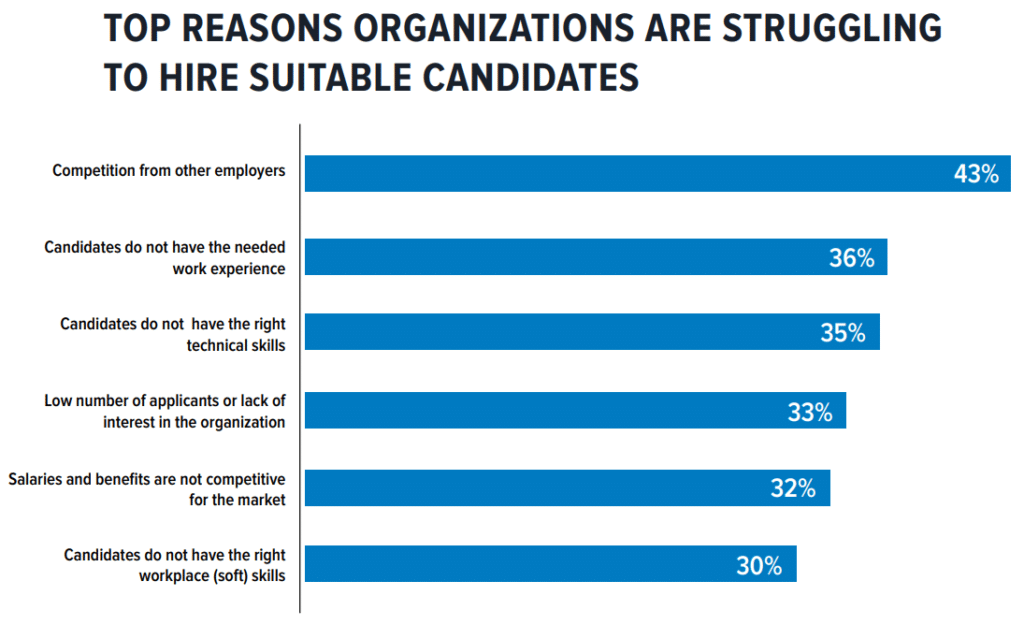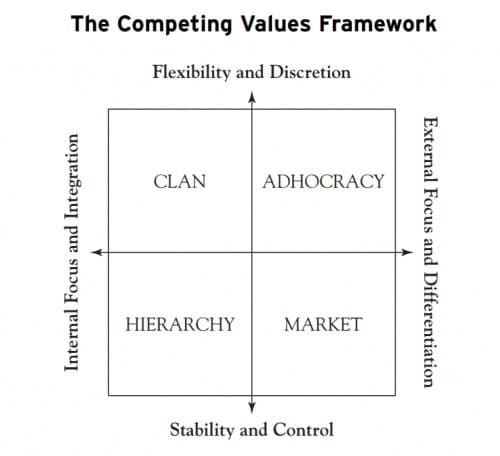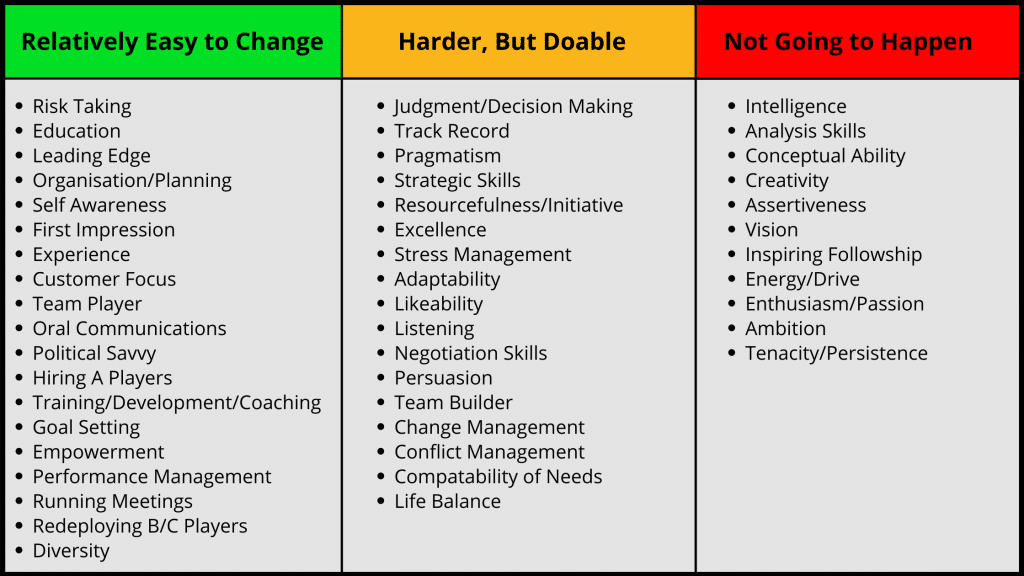What’s the hardest part about hiring? How do millennials approach job searches?
Finding high-quality candidates for the roles in your organization. According to the Jobvite Recruiter Nation report, 58 percent of recruiters stated that a “Lack of skilled/qualified candidates and competition from other employers remain the biggest challenges in hiring quality talent.”
It’s hard for everyone.
In fact, 52 percent of recruiters list improving quality-of-hire as their top priority when filling a specific role.
Why companies struggle to hire qualified candidates
The vast majority of employers are struggling to find qualified candidates for specific positions in their organization. A recent SHRM survey found that 83 percent of respondents have had trouble recruiting quality candidates in the last 12 months.
"More than a third report a decrease in applicant quality across the board, and 45% report a decrease in quality for specific positions."
The question is, why?
Let’s take a look at the top six reasons behind this growing trend.

So to summarize:
- Competition from other employers (for the same role)
- Interest from candidates who don’t have the work experience or technical skills needed
- A low number of applicants or a lack of interest in your company
- Low/poor salaries and benefits
- Interest from candidates who lack the workplace “soft skills” needed
How are you supposed to fix these problems?
At first glance, this may sound intimidating, as if this is going to take a tremendous about of time, effort, resources, and energy. Yes, it will take work, but the process doesn’t have to be excruciating. In fact, the process can be enjoyable with the right approach.
Let’s take a look at a few of the options we can use to solve these issues.
1. Competition from other employers (for the same role)
The solution to this problem is simple.
Offer qualified candidates what other employers can’t or won’t offer. Are employers offering a higher salary than you can afford? Offer stock options, profit sharing, bonuses, referral fees, or other incentives employees are interested in to attract their attention.
Find creative ways to reward employees for their hard work.
If you’re looking to build a sales team, you could rework your bonus or incentive structure. If competitors offer a large commission, offer a salary with larger performance bonuses that incentivize hard work.
Look at your culture.
Then, reward the behavior you want.
Robert E. Quinn and Kim S. Cameron at the University of Michigan at Ann Arbor discovered four types of organization cultures.

1. Adhocracy cultures are temporary and driven by rapid change. These firms reconfigure themselves rapidly in the face of change. They’re adaptable, flexible, and creative in the face of uncertainty, ambiguity, and disruption. If you’re running a sales team, this may mean a lot of turnover, repeatedly retraining your team, constantly shifting roles, or something else.
2. Clan cultures are family-like; there’s a focus or special emphasis placed on mentoring, nurturing, and investing in the growth of those in the clan. It’s all about doing and accomplishing together. Prioritizing employee development is crucial — an emphasis on engagement, commitment, and loyalty are essential and non-negotiable. If you want to retain your employees in this culture, you’ll need to create a system and incentives that quickly integrate new employees into the group.
3. Hierarchy cultures follow a set social structure. These companies focus on perfection, efficiency, stability, and doing things the right way. There are clear lines of authority, standardized rules, and procedures; there are also control and accountability mechanisms. Integrating employees in this culture means you’ll need to place them on the right rung of the hierarchy ladder.
4. Market cultures are often utilitarian; they’re exclusively focused on results. The environment in market cultures is competitive, achievement-focused, and driven by outcomes and prestige, think commission sales. Market organizations are all about winning. They’re advancing all the time, defeating their competitors, moving rapidly towards their quotas and goals.”
Understanding the values framework in your organization is how you surpass your competitors. If you understand your organizational structure, you’ll find it’s easier to create job offers and want ads that appeal to those who are a cultural fit.
Doing this reduces competition dramatically.
This also enables you to create golden handcuffs that actually appeal to the candidates you’ve identified who are a fit for your company.
2. Interest from candidates who don't have the work experience or technical skills needed
If you’ve done the work to create the golden handcuffs, you have what you need to retain employees. What about the avalanche of unqualified candidates knocking on your door? What do you do with them?
It’s simple, train them.
You create a specific program that attracts potential candidates. You can approach this in a variety of ways, depending on your industry, business, product, or service.
- Paid and upaid internships
- 1099 to W2 work arrangements
- Temporary or trial employement
- In-school recruitment programs
These are opportunities in disguise.
When you train these inexperienced or underqualified candidates, it’s a win/win. There’s no emotional or political baggage from previous employers, no bad habits to unlearn, no unrealistic demands to sort through.
You’re the first.
You get the chance to train these candidates as you see fit.
What if these options aren’t a fit?
No problem, create an option that best fits your organizational goals and objectives. If you’ve created the golden handcuffs, you’ll retain the candidates you train. This reduces the risk that comes with training employees.
Yes, some will leave.
But many of the candidates you invest in will stick with you, especially if they know you’re going to look out for them.
3. A low number of applicants or a lack of interest in your company
If you’re struggling with a low number of applicants, you’ll want to evaluate a few items to identify where the problem lies.
· Poor reputation
· An uncompetitive job offer
· You’re an unknown player
Each of these issues is easy to fix.
If you are dealing with a poor reputation, use reputation management tools like Glassdoor to boost your reputation with candidates and employees. Claim, complete and optimize your company profile. This guide gives you step-by-step instructions you can use to optimize your Glassdoor profile.
Have you done that already?
Reach out to your employees and ask them to anonymously share their feedback, discussing their experience with the company. This needs to be organic; employees shouldn’t receive any incentives or rewards for writing a review.
How does this fix the problems I mentioned earlier?
1. Your aggregate reviews will begin showing up in Google search results in Google maps
2. You’ll receive more traffic and applicants as your visibility in Google improves
3. The quality and quantity of your applicants will improve
You can address each of these problems with one simple strategy. The best part about Glassdoor? It appeals to millennials and garners trust.
4. Low/poor salaries and benefits
Companies with considerable brand strength and strong reputations can attract top talent in spite of their below-average pay.
Tesla is a great example.
A recent survey by Robert Half found that 55 percent of workers tried to negotiate their salary during their previous job offer. Haggling is a very good sign that candidates are, at a minimum, invested in the process and willing to fight for what they want.
It’s so much better than being ghosted.
How do you adjust your compensation package, so you’re able to attract A-Player candidates? Start by defining your compensation philosophy.
· If you’re looking to lead the market, your compensation package (across all positions) will usually be about the 50th percentile.
· If you want to match the market, your compensation package will be between the 25th and 75th percentiles. If you’re taking the traditional route, compensation will be between the 30th and 40th percentiles.
· If you prefer to be a laggard, your compensation package is at or below the 25th percentile.
What do you want to do?
If your company already has a compensation philosophy, go with that. If you’re not sure how you’d like to approach the issue of compensation, take some time to think about it. Then, identify the steps you’ll need to take to match your compensation philosophy.
5. Interest from candidates who lack the workplace "soft skills" needed
Topgrading is a proven hiring methodology.
It enables employers to find, hire, and retain the top 10 percent of talent in a given market. One of the things that make Topgrading stand out is its list of core competencies.

These competencies guide you to A-Players.
According to Bradford Smart Ph.D., founder of Topgrading Inc., A players tend to be:
· Smart, intellectual, and business savvy
· Driven to succeed; passionate
· Trustworthy
· Consistent high performers
· Adaptable to adjust to many different personalities
· Surround themselves with high performers
· Very hard workers
· Resourceful; overcome obstacles
· Effective leaders
· Down-to-earth, well-grounded, self-aware, humble
What does this mean for candidates lacking the “soft skills” needed to be successful? You’ll need to determine whether you’re interested in training employees or not.
If you are, you’ll need to provide that.
What if you’re not interested in training candidates?
You’ll have fewer candidates to choose from, but they’ll be ready to go, more demanding, and focused on the work.
What do millennials look for in a position or role?
Remember my previous post?
Millennials are the job-hopping generation. A recent report from Gallup found 6 in 10 millennials are open to new job opportunities; 21% of millennials switched jobs in the last year. That may not seem like much until you realize that’s 3x every other non-millennial group.
Let’s quickly recap what millennials are looking for.
1. Millennials don’t just work for a paycheck — they want purpose. They want to work for organizations with strong values, a mission, and an overall purpose. Compensation is very important, but it’s not the main driver for millennials.
2. Millennials want professional development. They’re not interested in the typical command and control manager. They’re looking for a manager who’s akin to a coach. They want their manager to value them as people and employees; they expect their managers to work to understand them deeply.
3. Millennials want continuous feedback. Annual reviews aren’t compelling for these employees. They want a manager who’s willing to provide feedback on an as-needed basis, using the platforms they’re already familiar with — Slack, Skype, Twitter, texts, etc.
4. Millennials want to focus on their strengths. They don’t want to fix their weaknesses; Gallup data shows that strengths grow infinitely while weaknesses never really turn into strengths. This isn’t to say that it’s impossible; it’s simply not a priority for them.
5. Millennials view their job as a part of their life. They want a good job, one that’s fulfilling and fits with their values and cultural expectations. They’re asking themselves the question, “does this company give me the chance to do my best every day?”
How do millennials suss out these values in their job search?
· They look for the above items (1 to 5) in your landing pages, job descriptions, website, and offers
· They read employee reviews on sites like Glassdoor and LinkedIn, searching for these keywords and phrases
· They ask former employees, known contacts, and friends of friends about your company, their would-be coworkers, and the role you’re looking to fill
· Finally, they read to the terms and conditions in your offer; the reader employee manuals, download white papers and watched your videos
They’re looking for consistency.
The more consistency and agreement they see across each channel or source, the more comfortable they’ll feel accepting a role or position within your organization.
It’s that simple.
How do you tie all of this together?
Address the problems I’ve identified (items 1 to 5) and create a compelling solution for each of these. Doing this creates the golden handcuffs, incentivizes good employee performance, and boosts A-Player retention. Then, address the issues that are most important to millennials.
Layer your responses.
Use the usual recruitment channels you’re already using but add in tools like LinkedIn and Glassdoor if you haven’t already. Optimize your profile and request reviews from existing employees.
Remember, millennials are looking for consistency.
They want to see that your values are aligned with theirs.
Compensation is important, but so are the other details we’ve discussed today.
Millenials are perpetual job-hoppers
This isn’t because they’re lazy or disloyal.
Millennials are looking for a culture-fit. They want to find the company or organization that provides them with the opportunity and growth they need.
That’s a problem if you’re waiting for qualified candidates.
As we’ve seen, finding high-quality A-Player candidates for the roles in your organization is difficult for most. The competition for well-established candidates is fierce. If you’re willing to train your candidates from the ground up, you have a low-cost source you can mine to attract high-quality A-Player candidates.
Train millennials, and you provide them with the opportunity and growth they’re desperate for. Create the golden handcuffs, and you’ll find you’re able to attract, retain, and grow with the millennials in your organization. Invest in millennials, and you’ll find they’re the easiest part of hiring.




